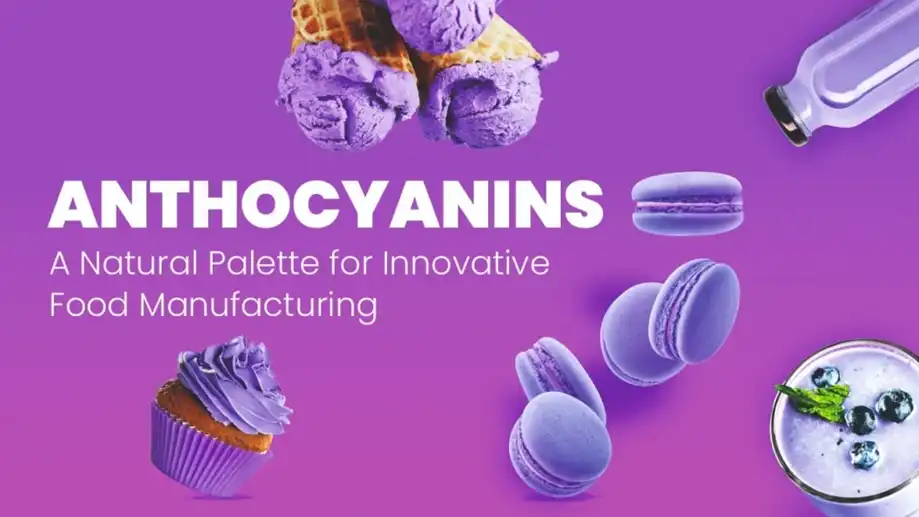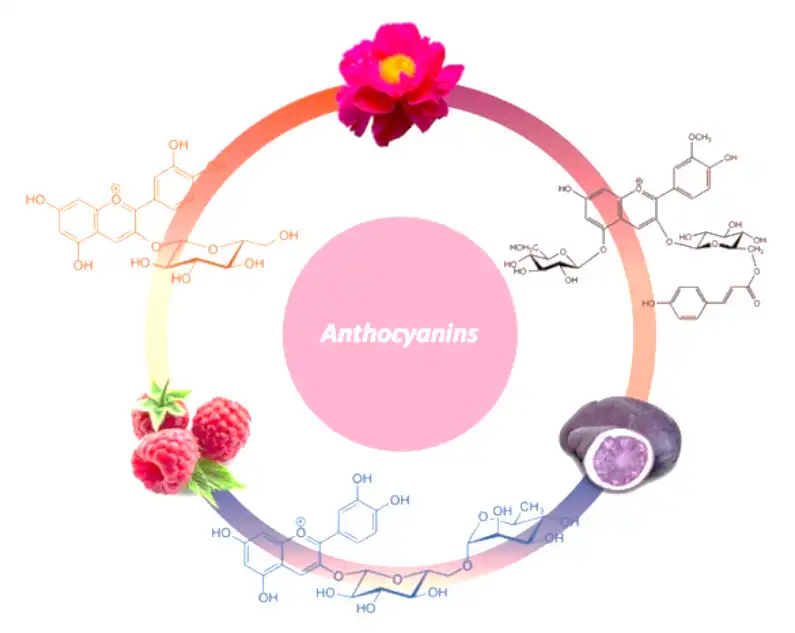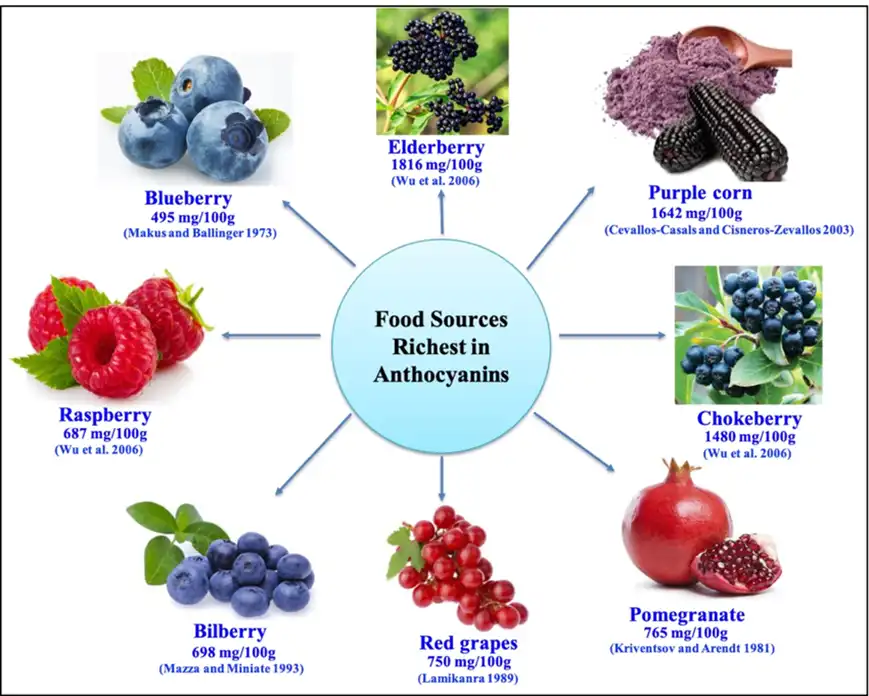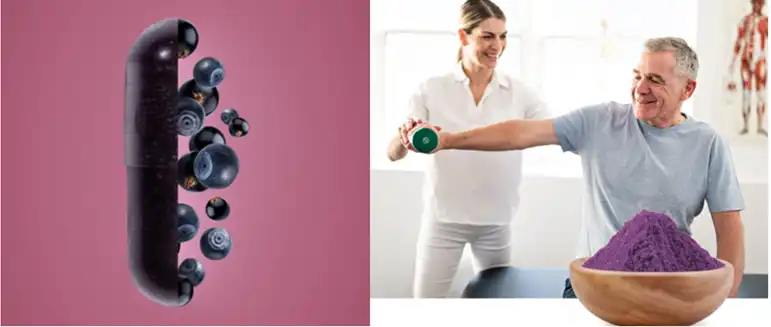What Are Anthocyanins? A Deep Dive into Nature's Vibrant Pigments
Color is always the first step in planning a successful product line. Anthocyanins are naturally occurring pigments found in many plants, responsible for the red, purple, and blue hues seen in fruits, vegetables, flowers, and even some leaves. These pigments belong to a larger class of compounds called flavonoids, which play essential roles in plant survival and human health. Anthocyanins are not only visually stunning but also powerful antioxidants with potential health benefits, making them a subject of interest for nutrition, medicine, and food science.
What are anthocyanins?
Anthocyanins (pronounced anth-o-sy-an-ins) are naturally-occurring pigments responsible for the bright colours in fruits and especially berries. As protective compounds, their role is to shield plants from everything that the environment throws at them.
Anthocyanins, and particularly those present in blackcurrants, have a unique bioactive profile and punch above their weight because of their exceptional nutritional value.
Many purple-coloured foods contain color pigments called anthocyanins. These plant pigments are water-soluble and have protective antioxidant properties for the plant and us, when we include them in our diet. Anthocyanins are found in many deep red, purple and blue fruit and vegetables.
One of the ground-breaking discoveries in nutritional science, anthocyanins are exciting international health experts and researchers, because of their universal potential for supporting human health and the meaningful contribution they can make to daily life.

The Science Behind Anthocyanins: A Colorful Chemistry
Anthocyanins are water-soluble pigments, meaning they dissolve in water and can easily spread through plant cells, giving color to petals, fruits, and leaves. Structurally, they’re a type of glycoside formed when a sugar molecule binds to an anthocyanidin. Their unique chemical structure allows them to absorb light at specific wavelengths, producing vibrant colors that vary based on pH levels.
Acidic environments (pH < 7) make anthocyanins appear red.
Neutral environments yield purple.
Alkaline conditions (pH > 7) turn them blue.
This color change is why red cabbage, for instance, can shift in color when cooked with different ingredients, and it allows anthocyanins to serve as natural pH indicators.
Structure of anthocyanins
|
Aglycone |
Substitution R1 |
Substitution R2 |
Absorbance (nm) visible spectrum |
|
Pelargonidin |
H |
H |
494 (orange) |
|
Cyanidin |
OH |
H |
506 (orange-red) |
|
Delphinidin |
OH |
OH |
508 (blue-red) |
|
Peonidin |
OCH3 |
H |
506 (orange-red) |
|
Petunidin |
OCH3 |
OH |
508 (blue-red) |
|
Malvidin |
OCH3 |
OCH3 |
510 (blue-red) |

Why Plants Produce Anthocyanins?
So, plants produce anthocyanins specifically when light intensity is high, but temperatures are low enough to slow photosynthesis. They produce anthocyanins to protect themselves against the damaging effects of collecting more energy than they can use:
Protection from UV Rays: Anthocyanins help protect plants from harmful ultraviolet (UV) rays by absorbing excess sunlight, which can damage cells.
Deterring Herbivores: The vibrant colors can act as a signal to predators that a plant may be toxic or unpleasant, discouraging grazing and consumption.
Attracting Pollinators: Flowers with anthocyanin pigments attract pollinators, aiding in plant reproduction.
Defense Against Stress: Plants produce more anthocyanins under stress conditions, such as extreme temperatures or drought, acting as a form of protection and adaptation.
Health Benefits of Anthocyanins: Not Just Pretty Pigments
Anthocyanins offer numerous health benefits that go beyond aesthetics. They are packed with antioxidants, which help neutralize harmful free radicals in the body and support various aspects of human health:
Heart Health: Studies suggest that anthocyanins can improve blood vessel function, reduce inflammation, and help maintain healthy blood pressure levels.
Anti-Inflammatory Properties: Anthocyanins may help reduce inflammation, which is associated with many chronic diseases, including arthritis and heart disease.
Potential Cancer Prevention: Preliminary research indicates that anthocyanins could help protect cells from DNA damage and inhibit the growth of cancer cells, though more studies are needed.
Brain Health: Anthocyanins may help protect the brain against oxidative stress, potentially supporting memory and cognitive health as people age.

What is the Common Anthocyanin-Rich Foods?
Anthocyanins are present in various fruits, vegetables, and grains that have red, purple, or blue hues. These colorful foods not only brighten up a plate but also provide a range of health benefits thanks to their potent antioxidant properties. Here’s a look at some of the most anthocyanin-rich foods you can incorporate into your diet:
Berries: Blueberries, blackberries, strawberries, and raspberries are particularly high in anthocyanins. Studies associate a regular and moderate intake of blueberries and other anthocyanin-rich foods with a reduced risk of cardiovascular disease and type-2 diabetes, as well as improved weight maintenance. More evidence, particularly human, is needed to better understand the potential health benefits of blueberries, although it is widely agreed that including them in your diet is beneficial.
Purple and Red Fruits and Vegetables: Red cabbage, eggplants, red onions, Purple sweet potatoes and black currants. Red cabbage is a nutrient-rich member of the brassica family and has been linked to a number of health benefits, including a healthier heart, improved gut function and lower risk of certain cancers. Increasing evidence supports the inclusion of red and purple fruit and vegetables in your diet, with improvements in obesity-related diseases such as type-2 diabetes.
On the other hand, Purple sweet potatoes have been in the spotlight over recent years. They are a staple on the Japanese island of Okinawa, which is home to an exceptionally healthy elderly population – a large number of which is over the age of 100. Rates of dementia on Okinawa are reported to be as much as 50 per cent lower than that in the west.
Purple Corn and Black Rice: These less-common grains are also anthocyanin-rich. Purple corn and black rice are rich in anthocyanins because these pigments accumulate in the outer layers (bran) of these grains, giving them their distinctive dark hues. Anthocyanins serve as antioxidants in these plants, protecting them from environmental stressors such as UV rays, pathogens, and other potential sources of damage.
Dark Grapes and Red Wine: Known for their high antioxidant content, these are significant sources of anthocyanins. Dark grapes, particularly varieties with deep purple or red skins, are some of the most anthocyanin-rich fruits available. The high anthocyanin content is largely concentrated in the skins, which give these grapes their vibrant color and contribute to their health-boosting properties. When dark grapes are processed into red wine, the anthocyanins in the grape skins are retained, making red wine another potent source of these beneficial compounds.

Anthocyanins in Food Production: A Natural Dye Solution
Anthocyanins are the most important group of water-soluble compounds responsible for the red, purple, and blue colors seen in flowers, fruits, and other parts of the plant. For centuries, these compounds have been consumed by man without obvious detrimental effects due to their bright colors and anti-inflammatory and antioxidant properties.
As consumers increasingly seek natural alternatives to synthetic dyes, anthocyanins are finding a place in the food industry as a natural colorant (E163). The interest in anthocyanin pigments is not only due to a potential replacement of artificial food colorings, but is also due to their pharmacological and therapeutic properties. Due to their color-shifting properties, anthocyanins are ideal for producing a range of colors in food, such as yogurts, beverages, and candies, appealing to consumers who prefer plant-based ingredients.
Anthocyanins are valued as food colorants because they’re derived from natural sources, aligning with consumer preferences for clean-label ingredients and reduced artificial additives. Beyond aesthetics, anthocyanins also provide antioxidant properties, which can add functional benefits to foods.

Enhance Your Product’s Appeal with Anthocyanins
Incorporating anthocyanins into your product is not just about color—it's about aligning your brand with the values of today’s informed and health-conscious consumers. Here’s why adding anthocyanins is a smart choice for your product:
1. Natural, Clean-Label Appeal: In an era where consumers are prioritizing transparency, anthocyanins offer a natural, plant-based alternative to synthetic dyes, helping you meet the growing demand for clean, recognizable ingredients. By using anthocyanins, you align your products with the values of today’s health-conscious consumers.
2. Vibrant, Customizable Colors: Anthocyanins provide a stunning range of shades, from deep reds to vibrant blues. Their pH-sensitive properties allow for customizable color adjustments, making them perfect for a variety of applications, from beverages to confectioneries, and ensuring that your products stand out on the shelf.
3. Added Health Benefits: Beyond their visual appeal, anthocyanins are packed with antioxidants, which support overall health by combating oxidative stress and inflammation. By adding anthocyanins, you offer consumers not just an appealing product, but one with potential health benefits, boosting your brand’s wellness appeal.
4. Market Differentiation: As demand for natural, sustainable ingredients increases, anthocyanins offer a way to differentiate your brand. By choosing anthocyanins, you demonstrate your commitment to innovation, sustainability, and the well-being of your customers, helping your product stand out in a competitive marketplace.
Make the Switch to Anthocyanins Today—Enhance Your Product’s Appeal, Boost Consumer Trust, and Stay Ahead of Market Trends!

Where to Buy Anthocyanins?
Discover the exceptional quality of Anthocyanins from YANGGE BIOTECH INGREDIENTS, available with a complimentary sample at yanggebiotech.com. Renowned as an industry leader, YANGGE BIOTECH is dedicated to manufacturing and distributing premium-grade dietary supplement ingredients, delivering purity and potency with every product. Not only does YANGGE BIOTECH serve health-conscious consumers directly, but it also partners with top brands across the food and supplement sectors, supplying raw, pure ingredients that meet the highest industry standards. Elevate your product offerings or personal wellness with our trusted ingredients—reach out to us today to place your order and experience the YANGGE difference.
Why Yangge Biotech is the Top Choice for Anthocyanins?
Yangge Biotech is renowned for producing premium-quality Anthocyanins, crafted through advanced extraction techniques that maintain color vibrancy and purity. Their commitment to sustainable sourcing and eco-friendly production makes them an ideal partner for companies focused on clean, natural ingredients. Yangge Biotech also offers tailored color solutions, achieving diverse shades from red to blue to suit different applications.
Their stringent quality control ensures compliance with global standards, including FDA and EU certifications. With robust customer support and industry expertise, Yangge Biotech provides both technical guidance and post-sales assistance, helping clients make the most of E163’s benefits. For consistent, high-quality natural coloring, Yangge Biotech stands out as the industry leader
Wrapping Up, Anthocyanins are more than just pigments – they’re multifunctional compounds with important benefits for both plants and humans. By adding anthocyanin-rich foods to your diet, you can enjoy not only a colorful plate but also a boost in health-supportive antioxidants. From their role in nature to their health benefits and applications in food production, anthocyanins offer a fascinating glimpse into the powerful properties hidden in nature’s vibrant palette. By choosing anthocyanins, you’re not just adding a vibrant, natural color to your products—you’re tapping into a growing consumer demand for transparency, sustainability, and health-conscious choices. Stay ahead of the competition and differentiate your brand with a clean-label, antioxidant-rich solution that resonates with today’s mindful consumers. Make the shift to anthocyanins and watch your products shine both in color and consumer appeal!
References
1.Horbowicz M, Kosson R, Grzesiuk A, et al. Anthocyanins of fruits and vegetables—Their occurrence, analysis and role in human nutrition. Vegetable Crops Research Bulletin. 2008;68:5
2.Durst R, Wrolstad R. Separation and characterization of anthocyanins by HPLC. In: Handbook of Food Analytical Chemistry. New Jersey: John Wiley & Sons; 2001. pp. 33-45
3.Garzón G. Anthocyanins as natural colorants and bioactive compounds: A review. Acta Biológica Colombiana. 2008;13(3):27-36
4.Escorza M, Y Salinas J. La capacidad antioxidante total. Bases y aplicaciones. Revista de Educación Bioquímica. 2009;28(3):89-101
5.Boss PK, Davies C, Robinson SP. Analysis of the expression of anthocyanin pathway genes in developing Vitis vinifera L. cv Shiraz grape berries and the implications for pathway regulation. Plant Physiology. 1996;111:1059-1066
6.Moreno Y, Sánchez G, Hernández D, Lobato N. Characterization of anthocyanin extracts from maize kernels. Journal of Chromatographic Science. 2005;43(9):483-487
7.Delgado F, Jiménez A, Paredes O. Natural pigments: Carotenoids, anthocyanins, and betalains-characteristics, biosynthesis, processing, and stability. Critical Reviews in Food Science and Nutrition. 2000;46(2):361-367
8.Loypimai P, Moongngarm A, Chottanom P. Thermal and pH degradation kinetics of anthocyanins in natural food colorant prepared from black rice bran. Journal of Food Science and Technology. 2016;53(1):461-470
9.Wong S, Lim Y, Chan W. Antioxidant properties of Hibiscus: Species variation, altitudinal change, coastal influence and floral colour change. Journal of Tropical Forest Science. 2009;21(4):307-315
10.Beltrán R, Alonso C, Aragonés G, Rodríguez I, Rull A, Micol V, et al. The aqueous extract of Hibiscus sabdariffa calices modulates the production of monocyte chemoattractant protein-1 in humans. Phytomedicine. 2010;17(3):186-191
11.Camelo G, Ragazzo J, Jimenez A, Vanegas P, Paredes O, Del Villar A. Comparative study of anthocyanin and volatile compounds content of four varieties of Mexican roselle (Hibiscus sabdariffa L.) by multivariable analysis. Plant Foods for Human Nutrition. 2013;68(3):229-234
Send Inquiry
Related Industry Knowledge
- what does blue spirulina powder taste like?
- What is Guarana and What are its Properties and Benefits?
- Unlocking the Power of Hydrolyzed Pea Protein: A Nutritional Marvel
- 9 Nuclear Radiation Natural Ingredients
- Epimedium Soap
- Pure Creatine Monohydrate Powder Flavored and Dosage
- Omega 3 epa vs dha
- The function and application of Yeast Extract GlutathioneYeast Extract Glutathione
- L Ergothioneine Powder: Uses and Benefits
- Is Butterfly Pea Tea Safe?


